Mardi Gras Decoration
What Mardi Gras Beads Represent?
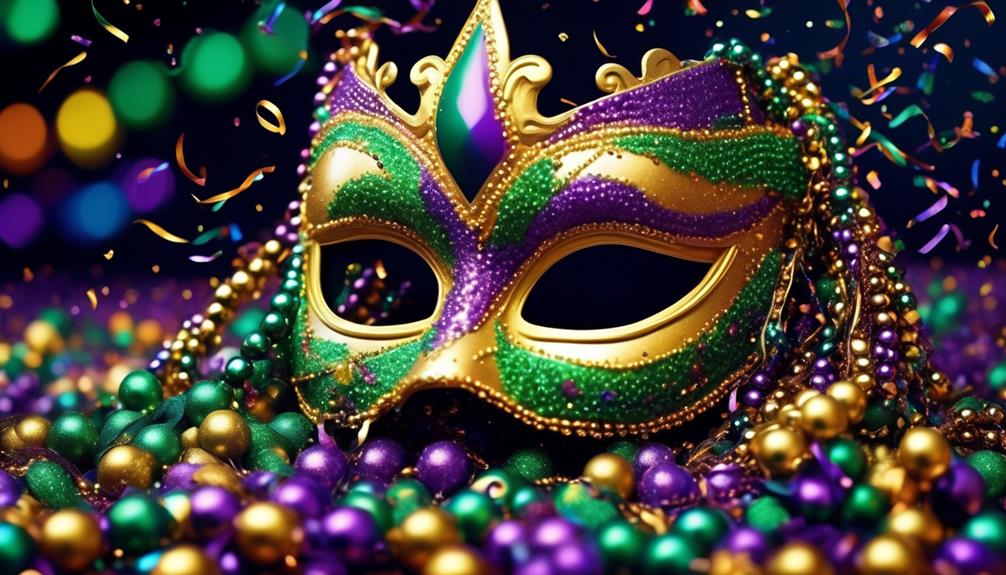
Have you ever thought about the true meaning behind Mardi Gras beads?
These colorful strands have become an iconic symbol of the festive celebrations, but their meaning runs deeper than simply being a dazzling accessory. From their origins to the cultural significance they hold today, Mardi Gras beads carry a rich history and symbolism that continues to captivate and intrigue.
But what do these beads really stand for?
Join us as we unravel the mystery behind the significance of Mardi Gras beads and discover the layers of meaning woven into these vibrant tokens of celebration.
Key Takeaways
- Mardi Gras beads represent generosity and goodwill, evolving from being thrown from parade floats to engage with the crowd.
- The colors of Mardi Gras beads hold cultural significance, with purple symbolizing justice, gold signifying power, and green representing faith.
- Mardi Gras beads symbolize celebration, unity, and the spirit of Mardi Gras in parades, adding excitement and community engagement.
- Mardi Gras beads foster camaraderie, promote inclusivity, and serve as a tangible link to cultural heritage, strengthening bonds and enhancing collective spirit.
Origins of Mardi Gras Beads
The origins of Mardi Gras beads can be traced back to the early 19th century when these colorful trinkets became an integral part of the celebration's traditions. Bead manufacturing played a crucial role in the evolution of Mardi Gras beads. In the early days, the beads were made from glass, which was imported from countries like Czechoslovakia. Eventually, the production shifted to the United States, with New Orleans becoming a hub for bead manufacturing. This shift not only made the beads more accessible but also allowed for the incorporation of a wider array of colors and designs.
Bead distribution also played a significant role in shaping the Mardi Gras bead tradition. In the beginning, these vibrant beads were thrown from parade floats as a way for krewes to engage with the crowd. Over time, this act of throwing beads evolved into a symbol of generosity and goodwill. The tradition of bead distribution transformed into a way for revelers to share the spirit of Mardi Gras with others, creating a sense of unity and camaraderie among participants.
This act of giving and receiving beads during the festivities has become deeply intertwined with the cultural fabric of Mardi Gras, symbolizing the spirit of celebration and community.
Evolution of Bead Traditions

Having witnessed the evolution of Mardi Gras bead traditions over the years, we have observed a remarkable shift in the ways these vibrant trinkets have come to symbolize the spirit of celebration and community. From their origins as simple glass baubles to the multi-colored, multi-shaped treasures of today, Mardi Gras beads have undergone a fascinating transformation, reflecting changes in society and culture.
| Traditional Exchange | Modern Interpretations | Symbolism |
|---|---|---|
| Bead throwing from floats to crowd | Custom bead designs representing local culture and traditions | Unity and diversity |
| Passing beads hand to hand | Beads as fashion accessories, often worn year-round | Individual expression |
| Bead exchange during Mardi Gras balls | Beads used in art and craft projects, connecting creators with Mardi Gras spirit | Creativity and connection |
The bead exchange, once a simple gesture of goodwill, has now become a dynamic form of communication, each bead carrying its own story and significance. Modern interpretations have turned these beads into more than just trinkets; they have become emblems of unity, diversity, individual expression, and creativity. This evolution reflects the deep-rooted traditions of Mardi Gras while embracing the changing dynamics of contemporary culture.
Symbolism in Bead Colors
The colors of Mardi Gras beads hold deep cultural and historical significance, reflecting a rich tapestry of traditions and meanings. Each color carries its own symbolic weight, often rooted in the cultural and religious practices of the communities that celebrate Mardi Gras.
Understanding the significance of these colors provides a window into the vibrant history and cultural diversity of this beloved festival.
Color Meanings
Color meanings in Mardi Gras beads hold significant cultural and historical symbolism, reflecting the rich traditions and celebrations associated with this vibrant festival.
The color psychology of Mardi Gras beads is deeply rooted in the festival's history, with each hue carrying its own unique significance. Purple symbolizes justice, gold signifies power, and green represents faith.
These colors originated from the 1892 Rex Parade, where the Grand Duke Alexis Romanoff of Russia selected them to honor the visit of the Russian Grand Duke.
Additionally, the bead manufacturing process adds another layer of meaning. The vibrant colors are achieved through a meticulous dyeing process, further emphasizing the care and attention to detail that goes into creating each strand.
Understanding the symbolism and color psychology behind Mardi Gras beads adds depth and significance to the cherished tradition.
Cultural Significance
Deeply embedded in the cultural fabric of Mardi Gras festivities, the symbolic meanings of bead colors reflect a historical tapestry of traditions and celebrations. The colors of Mardi Gras beads hold significant cultural significance, with each color representing a unique symbol. The production of these beads involves a meticulous process, with artisans carefully selecting and dyeing materials to create the vibrant hues. Once produced, these beads are distributed throughout the community, becoming an integral part of the Mardi Gras experience.
| Bead Color | Symbolism |
|---|---|
| Purple | Represents justice |
| Gold | Signifies power |
| Green | Symbolizes faith |
The cultural significance of these colors is deeply rooted in the history of Mardi Gras and adds a layer of meaning to the festivities, connecting present-day celebrations to their rich historical origins.
Tradition and History
Embedded in the historical tapestry of Mardi Gras festivities, the symbolic meanings of bead colors resonate with the deeply rooted traditions and celebrations of this vibrant cultural event.
The history of Mardi Gras beads dates back to the 19th century, when the tradition of throwing colorful beads to parade-goers began. Purple represents justice, gold signifies power, and green symbolizes faith – these colors were chosen in 1872 to honor the visiting Russian Grand Duke Alexei Alexandrovich.
Over time, the evolution of bead colors has reflected societal changes and cultural shifts. The cultural importance of bead colors lies in their ability to encapsulate the spirit of Mardi Gras and convey a sense of unity and celebration.
However, it's crucial to consider the environmental impact of bead production, as the traditional plastic beads have raised concerns about their ecological footprint.
Role in Mardi Gras Parades
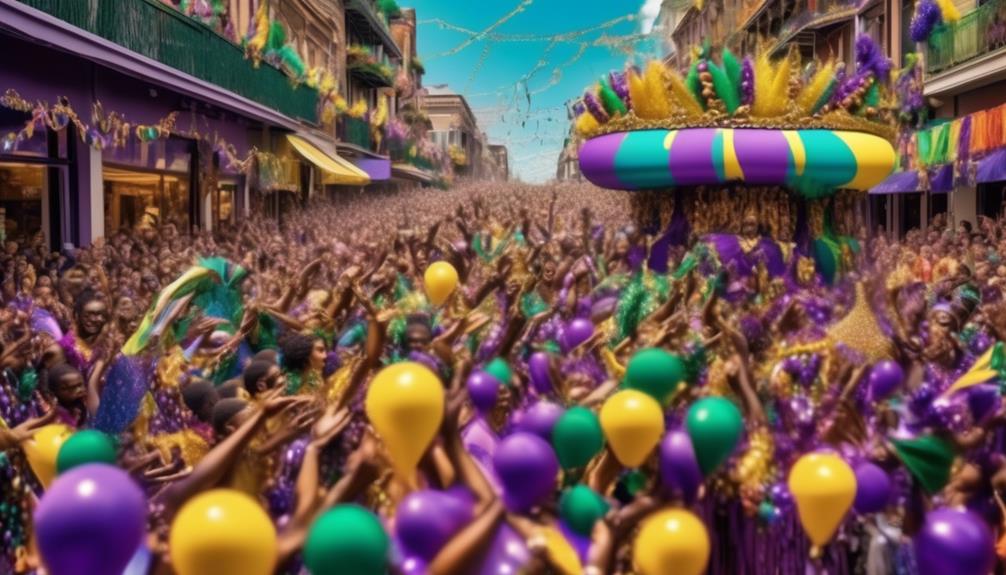
Mardi Gras parades are a vibrant display of culture and tradition. The role of beads in these parades is deeply rooted in the celebration's history.
The tradition of throwing beads to parade-goers is a symbol of joy and festivity, reflecting the spirit of Mardi Gras. These colorful strands have become an iconic part of the parade experience, embodying the lively and communal nature of the event.
Parade Throw Tradition
The tradition of parade throws during Mardi Gras plays a pivotal role in the lively and interactive nature of the festivities, adding an element of excitement and community engagement to the celebratory parades. This tradition fosters a sense of togetherness and camaraderie among parade-goers, as revelers eagerly await the colorful and vibrant throws from the passing floats. The act of catching these throws has become an integral part of Mardi Gras parade etiquette, symbolizing not just a fun activity but also a form of social interaction. The table below provides an overview of some of the most popular parade throws and their significance in the Mardi Gras tradition.
| Parade Throw | Symbolism |
|---|---|
| Beads | Friendship, unity, and the spirit of Mardi Gras |
| Doubloons | Prosperity and good fortune |
| Stuffed Animals | Joy, playfulness, and a sense of whimsy |
| Moon Pies | Nourishment and abundance |
Symbol of Celebration
Amidst the vibrant colors and lively music of Mardi Gras parades, the tradition of parade throws, particularly the iconic beads, assumes a significant role as a symbol of celebration, embodying the spirit of unity and festivity.
These celebratory accessories hold profound historical and cultural significance, serving as festive symbols that unite revelers in shared joy and merriment. The act of catching beads during a parade fosters a sense of camaraderie among the crowd, creating an atmosphere of communal revelry.
Additionally, the tossing of beads from elaborate floats symbolizes the tradition of generosity and goodwill, spreading happiness and delight to all. These beads also represent the exuberant and inclusive nature of Mardi Gras, encapsulating the essence of celebration and togetherness.
Cultural Significance Today
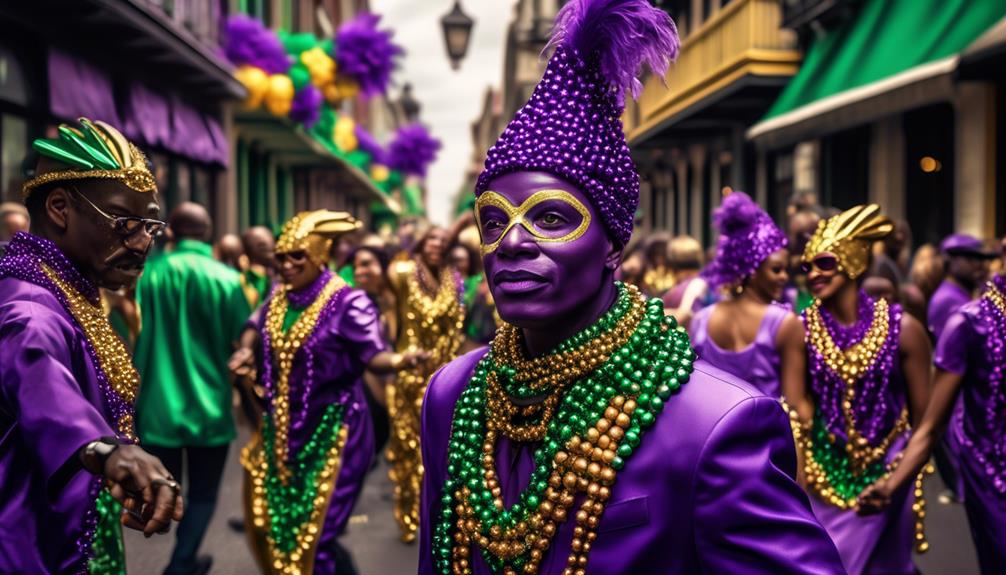
In today's cultural landscape, Mardi Gras beads continue to hold significance as a vibrant symbol of celebration, community, and tradition. The bead exchange during Mardi Gras represents more than just a token of festivities; it embodies a cultural exchange, where people from diverse backgrounds come together to revel in the joyous spirit of the carnival. This tradition fosters a sense of camaraderie and inclusivity, transcending barriers and uniting individuals in shared merriment. The act of exchanging Mardi Gras beads has evolved into a powerful symbol of cultural exchange, reflecting the rich tapestry of traditions and histories interwoven within the festival.
Furthermore, the cultural significance of Mardi Gras beads today also speaks to the resilience of tradition in the face of modernity. Despite the ever-changing dynamics of society, these beads serve as a tangible link to the past, connecting us to our cultural heritage and reminding us of the enduring legacy of this vibrant celebration. As we continue to embrace the cultural significance of Mardi Gras beads, we honor the customs of our ancestors while also shaping the cultural landscape of tomorrow.
Tradition of Bead Throwing
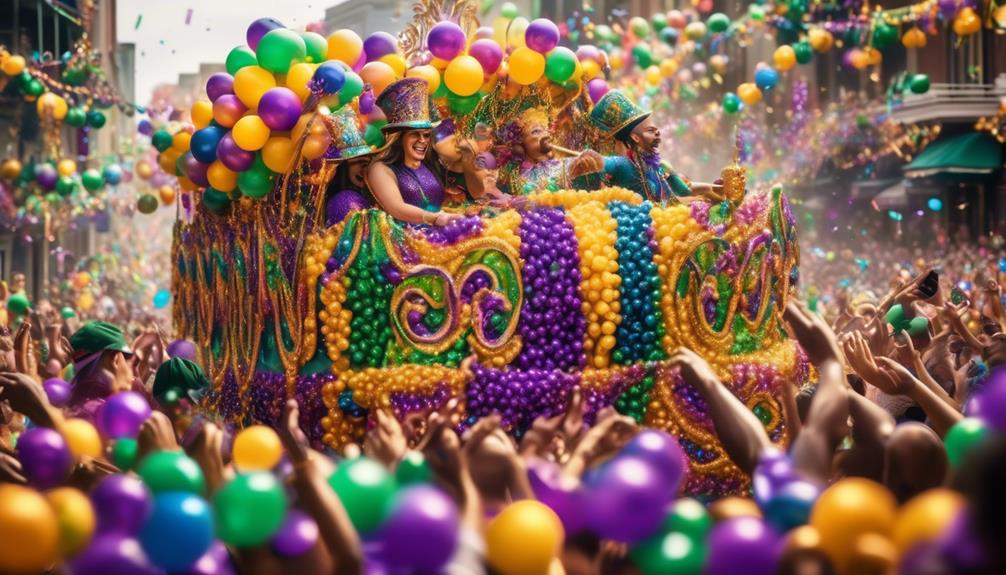
During the vibrant festivities of Mardi Gras, the tradition of bead throwing encapsulates a rich tapestry of cultural exchange and communal revelry, embodying the spirit of celebration and inclusivity. As beads are flung through the air, they carry with them a sense of history and tradition, connecting present-day revelers to the roots of this time-honored practice.
- Bead Etiquette and Parade Manners: The act of catching beads during Mardi Gras parades comes with its own set of unspoken rules and expectations. Understanding these customs adds depth to the experience, fostering a sense of camaraderie among parade-goers.
- Bead Economy and Local Business: The production and sale of Mardi Gras beads greatly impact local economies. From small family-owned businesses to larger manufacturers, the bead trade is a significant part of the economic landscape during the Mardi Gras season.
- Historical Significance: The tradition of throwing beads has evolved over the years, but its historical roots remain a vital part of the Mardi Gras experience. Exploring the origins of this tradition provides insight into its enduring cultural importance.
- Cultural Impact: The act of bead throwing goes beyond mere spectacle. It's a reflection of the values and traditions that have shaped Mardi Gras into the vibrant celebration it's today. Understanding the cultural impact of bead throwing enriches the experience for both participants and spectators.
Connection to Krewes
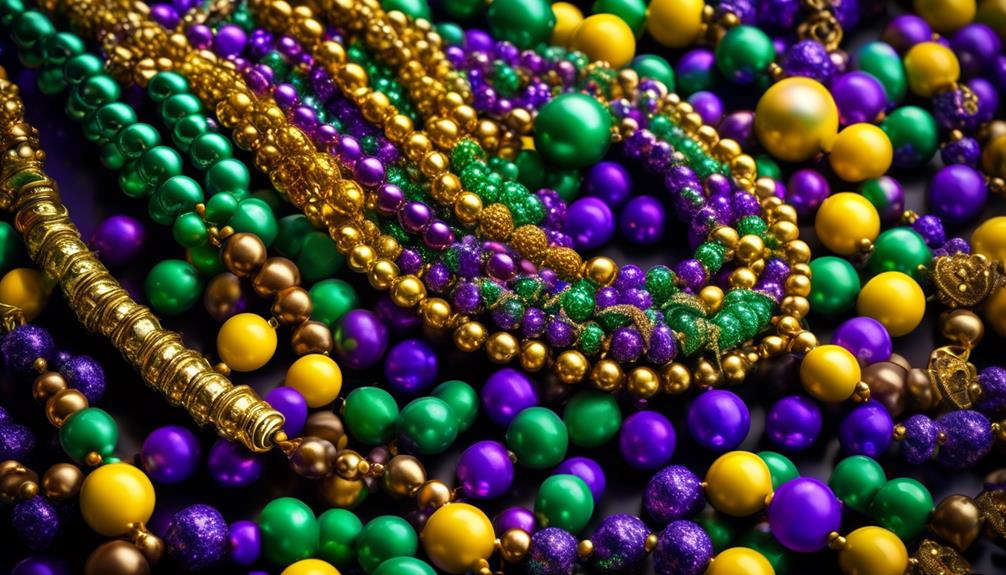
As we explore the connection between Mardi Gras beads and krewes, it becomes evident that the traditions of krewes play a significant role in the distribution and symbolism of these colorful trinkets.
The history and customs of various krewes shed light on the cultural significance of Mardi Gras beads, serving as a reflection of social status and community identity.
Understanding the connection to krewes unveils a deeper understanding of the intricate layers of symbolism and tradition embedded within the Mardi Gras celebration.
Krewe Traditions
Rooted in the rich cultural heritage of New Orleans, the traditions of krewes play a significant role in shaping the vibrant tapestry of Mardi Gras celebrations. The Krewe traditions are steeped in historical significance and cultural context, adding depth to the festivities.
Some of the key elements that define Krewe traditions include:
- Elaborate Parade Floats: Each Krewe meticulously designs and crafts elaborate parade floats, often with intricate themes and stunning designs that captivate and enchant spectators.
- Spectacular Costume Designs: Krewes pride themselves on creating stunning and elaborate costume designs, often with intricate details and vibrant colors that reflect the unique identity of each Krewe.
- Royal Court Ceremonies: Krewes uphold the tradition of selecting a royal court, including a king, queen, and court members, who play integral roles in Mardi Gras festivities.
- Masked Balls: Krewes host glamorous masked balls, steeped in tradition and elegance, where members and guests don exquisite masks and costumes, adding an air of mystery and allure to the celebrations.
Social Status Symbolism
The social status symbolism inherent in the traditions of krewes during Mardi Gras is a reflection of the historical and cultural significance of these organizations within New Orleans' vibrant tapestry of celebrations.
Krewes, with their opulent balls and elaborate parades, have long been associated with social hierarchy and exclusivity. Membership in prestigious krewes has historically been a marker of wealth and influence, serving as a platform for displaying one's social standing within the community.
The elaborate costumes and lavish attire worn by krewe members during Mardi Gras further emphasize the fashion statement and reinforce the social status symbolism.
These traditions not only reflect historical class distinctions but also continue to shape the contemporary cultural landscape of Mardi Gras, providing insight into the intricate interplay between social status, tradition, and celebration in New Orleans.
Impact on Community Spirit

Incorporating Mardi Gras beads into our community festivities has fostered a sense of unity and camaraderie among our residents, creating a vibrant and inclusive environment during the celebrations. The impact of Mardi Gras beads on community spirit is profound, with the tradition serving as a powerful symbol of togetherness and collective joy.
Here's why Mardi Gras beads have had such a significant impact on our community spirit:
- Shared Tradition: The act of exchanging and catching Mardi Gras beads during parades and events creates a shared experience that brings people together, fostering a sense of belonging and unity.
- Inclusive Environment: The tradition of throwing and catching beads encourages interaction and engagement among community members, breaking down social barriers and promoting inclusivity.
- Generosity and Kindness: The act of giving and receiving Mardi Gras beads fosters a spirit of generosity and kindness, reinforcing the values of goodwill and connection within our community.
- Fostering Community Pride: The vibrant display of Mardi Gras beads during festivities instills a sense of pride and excitement, contributing to a collective celebration of our community's culture and identity.
The presence of Mardi Gras beads in our community festivities has undoubtedly contributed to the creation of a joyous and inclusive atmosphere, strengthening our bonds and enhancing our collective spirit.
Mardi Gras Beads in Pop Culture
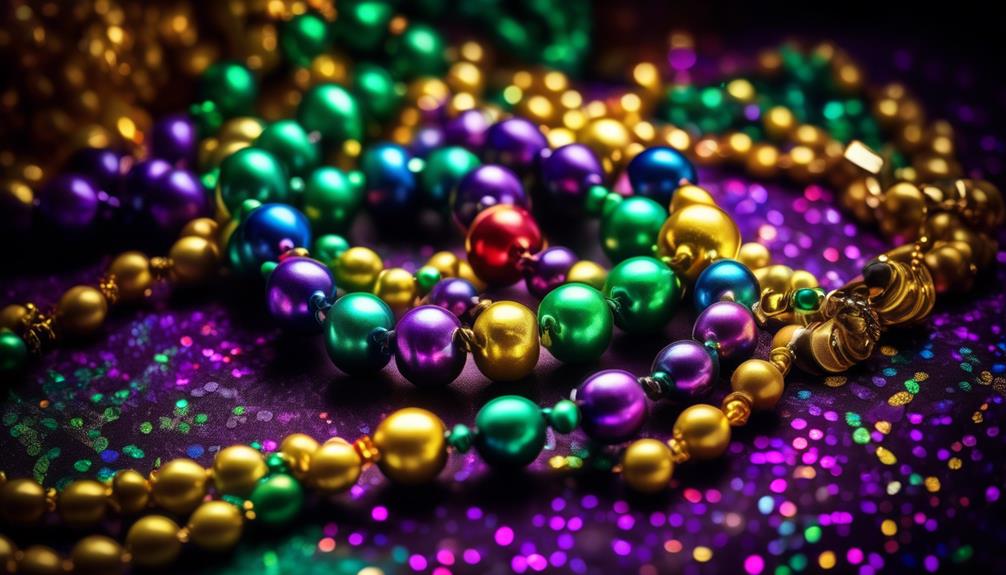
Mardi Gras beads have become ubiquitous symbols of revelry and celebration in contemporary popular culture, embodying the exuberance and festive spirit associated with the annual festivities.
In recent years, these vibrant strands of beads have transcended their traditional association with Mardi Gras and have made a significant impact on bead fashion. They're no longer confined to the realm of Fat Tuesday; instead, they've become a trendy accessory, adorning fashion runways and influencing street style. The playful and colorful nature of Mardi Gras beads has inspired designers to incorporate them into their collections, adding a touch of whimsy and joy to the fashion world.
Moreover, Mardi Gras beads have garnered attention through celebrity endorsements. Influential figures in the entertainment industry have been spotted wearing these beads at various events, further propelling their popularity. The endorsement by celebrities has contributed to the mainstream acceptance of Mardi Gras beads as a symbol of fun and festivity, extending their reach beyond the boundaries of New Orleans.
As a result, these beads have become more than just festive trinkets; they've evolved into a cultural phenomenon, representing joy, inclusivity, and the vibrant spirit of Mardi Gras.
Environmental Considerations

Considering the environmental impact of the widespread use of Mardi Gras beads is crucial in understanding their role in contemporary culture and the potential sustainability challenges they pose. Mardi Gras beads, often made of plastic, have a significant environmental impact, especially in regions where Mardi Gras celebrations are prevalent.
- Plastic Pollution: The extensive use of plastic beads during Mardi Gras contributes to plastic pollution, as many of these beads end up in landfills or waterways.
- Waste Management: The disposal of Mardi Gras beads presents a challenge for waste management systems, as the beads aren't easily biodegradable.
- Resource Depletion: The production of Mardi Gras beads consumes natural resources, adding to the overall environmental impact of these celebratory items.
- Sustainable Alternatives: Exploring and promoting sustainable alternatives to traditional Mardi Gras beads could mitigate their environmental impact and promote eco-friendly practices within the Mardi Gras culture.
Understanding the environmental implications of Mardi Gras beads is essential for individuals and communities to make informed decisions and take steps toward reducing the environmental footprint associated with these iconic items.
Collecting and Trading Culture

The environmental impact of Mardi Gras beads has spurred a vibrant collecting and trading culture deeply rooted in the traditions of this festive celebration. Bead collecting has become a cherished tradition, with individuals seeking out unique and rare beads to add to their collections. The act of collecting these beads holds a significant cultural and historical significance, as each bead tells a story of the celebratory spirit of Mardi Gras.
Trading culture has also flourished around Mardi Gras beads, with enthusiasts coming together to exchange beads of varying colors, sizes, and designs. This practice fosters a sense of community and camaraderie, as individuals bond over their shared love for these vibrant tokens of celebration. The trading culture not only adds an extra layer of excitement to the Mardi Gras festivities but also serves as a means of preserving and passing down the traditions associated with these beads.
Through bead collecting and trading culture, the essence of Mardi Gras is kept alive, allowing for the continuous celebration and appreciation of this beloved tradition.
Frequently Asked Questions
How Do People Typically Acquire Mardi Gras Beads Before the Parades?
Before the parades, we typically acquire Mardi Gras beads through various means, such as catching them from float riders or buying and trading with fellow revelers. These traditions add to the excitement and camaraderie of the event.
Acquiring beads becomes a fun and interactive part of the celebration, fostering a sense of community and shared experience. It's a joyful way to connect with others and be part of the vibrant parade atmosphere.
Are There Any Superstitions or Traditions Surrounding the Wearing of Mardi Gras Beads?
Superstitions and traditions surround the wearing of Mardi Gras beads, symbolizing more than just festive adornment. These beads hold cultural significance, representing luck, prosperity, and camaraderie.
Throughout history, they've become intertwined with the spirit of celebration and the essence of Mardi Gras. Generously shared among revelers, these beads foster a sense of community and joy.
Wearing them isn't just a fashion choice but a nod to the rich traditions and superstitions of this vibrant festival.
What Are Some Lesser-Known Ways That Mardi Gras Beads Are Used in New Orleans Outside of the Festival Season?
Outside of the festival season, Mardi Gras beads are creatively reused and recycled in New Orleans. The community engages in various projects, like bead art installations and upcycling workshops.
These initiatives not only promote environmental sustainability but also serve as a form of creative expression. Beads are repurposed into jewelry, home decor, and even costumes.
This highlights the deep cultural significance of Mardi Gras beads and their enduring impact on the city's artistic landscape.
Are There Any Specific Rules or Etiquette Regarding the Throwing and Catching of Mardi Gras Beads During Parades?
When it comes to bead etiquette at Mardi Gras parades, there's an unspoken frenzy of excitement. The rules for parade throwing are simple but vital: aim high, spread the joy, and watch out for revelers.
On the flip side, bead catching involves quick reflexes, a bit of showmanship, and a whole lot of luck. The parade rules for catching vary, but it's all about the thrill of the chase and the joy of the catch.
How Have Mardi Gras Beads Been Used to Raise Awareness for Social or Political Causes in Recent Years?
Mardi Gras beads have become powerful symbols for social causes and political awareness. In recent years, they've been used in fundraising events and community outreach, serving as tangible reminders of solidarity and support.
These beads have been cleverly incorporated into various campaigns, raising awareness for issues like environmental conservation, LGBTQ+ rights, and healthcare access. Their ability to spark conversations and unite people around important causes is truly remarkable.
Conclusion
In conclusion, Mardi Gras beads may seem like just colorful trinkets, but their cultural and historical significance runs deep.
From their origins in European and African traditions to their role in modern day parades, these beads are more than just accessories – they represent community, celebration, and the spirit of Mardi Gras.
So next time you catch a bead at a parade, remember that there's a whole lot more to it than meets the eye.
- About the Author
- Latest Posts
Introducing Ron, the home decor aficionado at ByRetreat, whose passion for creating beautiful and inviting spaces is at the heart of his work. With his deep knowledge of home decor and his innate sense of style, Ron brings a wealth of expertise and a keen eye for detail to the ByRetreat team.
Ron’s love for home decor goes beyond aesthetics; he understands that our surroundings play a significant role in our overall well-being and productivity. With this in mind, Ron is dedicated to transforming remote workspaces into havens of comfort, functionality, and beauty.
Mardi Gras Decoration
Mardi Gras Decor Ideas: Bringing New Orleans Flair to Your Home
Get inspired with vibrant Mardi Gras decor ideas to transform your home into a festive New Orleans celebration that your guests won’t forget!
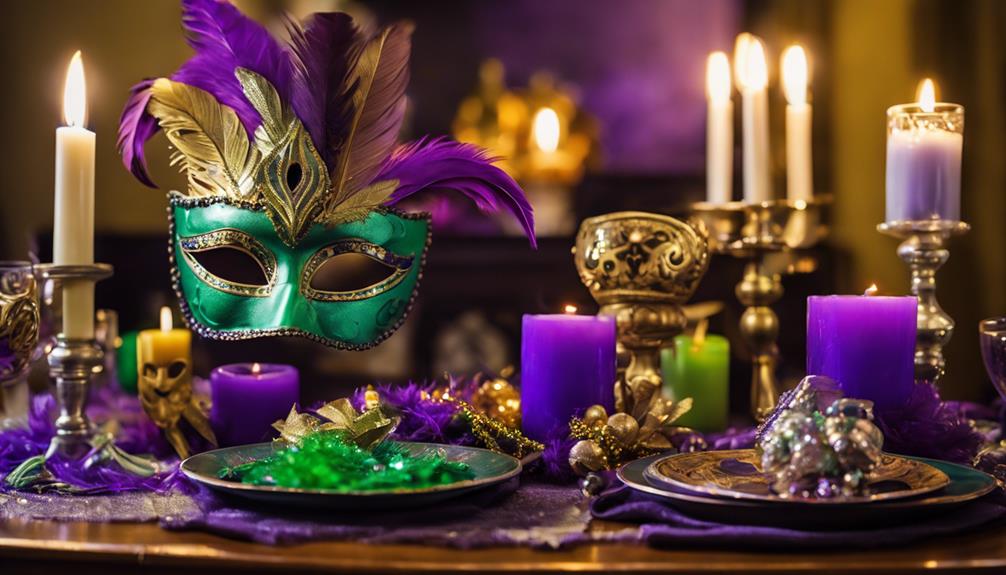
To bring the vibrant flair of New Orleans Mardi Gras into your home, embrace bold colors like purple, green, and gold. Add festive elements like masks, beads, and king cake to create an authentic atmosphere. Use a crisp white tablecloth to highlight colorful dishes and DIY decorations, like painted glassware or custom banners. Engage your guests with a themed coffee bar and vibrant centerpieces. Don't forget to design your space for conversation and fun. With these ideas, your Mardi Gras celebration will be unforgettable. Explore more creative tips to enhance your festive ambiance further!
Key Takeaways
- Embrace bold colors like purple, green, and gold to capture the essence of Mardi Gras and create a festive atmosphere.
- Incorporate traditional elements such as masks, beads, and king cake to enhance authenticity and celebrate New Orleans culture.
- Use a crisp white tablecloth as a backdrop to make vibrant decorations pop for an eye-catching table setting.
- Engage in DIY projects, like painting glassware and creating bead curtains, to add a personal touch to your decor.
Celebrate With Bold Colors
To truly celebrate Mardi Gras, you should embrace bold colors like purple, green, and gold, which capture the essence of this vibrant festival.
These bright colors not only symbolize justice, faith, and power, but they also bring an energetic flair to your home. Start with simple decorating ideas that incorporate these hues in your interior design. You might love to see table settings adorned with vibrant napkins and centerpieces that reflect the spirit of Mardi Gras.
Consider DIY projects that are budget friendly, like painting glassware in these festive colors or creating custom banners.
Adding colorful masks and beads as decorative accents can also enhance the festive theme, evoking the excitement of Mardi Gras parades right in your living space.
Don't overlook the power of floral arrangements; choose seasonal blooms in bold hues to serve as focal points in your home.
With these decorating ideas, you'll create a lively atmosphere that truly celebrates the spirit of Mardi Gras, inviting friends and family to join in the fun.
Essential Mardi Gras Elements

What essential elements should you include to create an authentic Mardi Gras celebration?
Start with a crisp white tablecloth as your base to enhance the vibrant colors of your decor. Incorporate classic Mardi Gras elements like king cake, masks, and beads, which capture the spirit of this festive occasion. Use simple white dishes for versatility and consider personalizing them with DIY plate decorations using glass paint markers.
To elevate your dining experience, add vintage candleholders and colorful drip candles, creating a warm and inviting ambiance. Gold napkins paired with Mardi Gras beads as decorative napkin rings will bring a touch of elegance to your table setting.
Don't forget about the festive beverages! Serve kids Abita Root Beer while adults can enjoy traditional offerings like Café Du Monde coffee and beignets.
These essential components won't only enhance the overall look of your Mardi Gras celebration but also immerse your guests in the rich cultural heritage of New Orleans. By including these elements, you'll create a lively atmosphere that captures the joy and excitement of Mardi Gras.
DIY Decor Projects

Enhancing your Mardi Gras celebration can be as simple as incorporating fun DIY decor projects that reflect the festive spirit of the occasion. These projects not only add a vibrant touch to your home but also create a warm and inviting atmosphere for your guests.
Here are some easy DIY decor ideas to get you started:
- Festive Bead Curtains: Create a curtain using strands of beads from Dollar Tree for just $3. This eye-catching display works great for entryways or windows.
- Themed Coffee Bar Sign: Paint a six-inch canvas with fun designs and add voodoo doll stitches for a unique sign that brings a playful touch to your coffee bar.
Tips for Hosting Parties

Hosting a memorable Mardi Gras party starts with a thoughtful layout that encourages conversation and keeps guests engaged. Assess your space and arrange furniture to create a welcoming atmosphere. Consider how guests will flow through the area, ensuring accessibility while mingling.
Use bold colors and festive decorations, like masks and beads, to enhance the celebratory spirit of your gathering. Think about incorporating multifunctional spaces—set up areas for dining, socializing, and entertainment. This allows guests to enjoy varied activities throughout the party.
To achieve cohesive decor, utilize themed elements such as a king cake centerpiece and vintage candleholders adorned with colorful candles. These details tie the room together and create a festive vibe.
As you're hosting parties, take note of how guests interact with your space. This can reveal areas for improvement, helping you make adjustments for future gatherings.
Incorporating Personal Style

Personalizing your Mardi Gras decor not only reflects your unique style but also makes your celebration feel more intimate and special. By showcasing unique treasures, like heirlooms and colorful pieces, you can weave your history into the festivities. Embrace bold colors—purple, green, and gold—to create lively spaces that resonate with your love for the holiday.
Here are some ideas to incorporate your personal taste:
- Use simple white dishes as a versatile base, allowing you to customize with themed elements like masks and beads.
- Engage in DIY projects such as painting personalized plates or crafting themed signs to add character and authenticity to your decor.
Frequently Asked Questions
When Should I Start Decorating for Mardi Gras?
You should start decorating for Mardi Gras at least a week before the event. This way, you'll have plenty of time to gather supplies and create vibrant displays that capture the festive spirit.
How Do You Have a Mardi Gras Party at Home?
To host a Mardi Gras party at home, you'll need vibrant colors, festive foods, lively music, and engaging activities. Set the scene, serve traditional dishes, and encourage creativity to create an unforgettable celebration.
How Do You Decorate for Mardi Gras?
To decorate for Mardi Gras, use vibrant colors like purple, green, and gold. Incorporate masks, beads, and themed vignettes. Consider DIY projects to personalize your space, adding vintage candleholders for an elegant, festive touch.
Conclusion
As you deck your home in vibrant purples, greens, and golds, it's funny how a celebration rooted in joy can remind you of life's chaos.
You might think you're just hanging beads and masks, but in reality, you're weaving a tapestry of memories, laughter, and community.
So, whether you're hosting a grand party or enjoying a quiet moment, remember: it's the spirit of Mardi Gras that transforms your space, turning your home into a joyous escape.
- About the Author
- Latest Posts
Introducing Ron, the home decor aficionado at ByRetreat, whose passion for creating beautiful and inviting spaces is at the heart of his work. With his deep knowledge of home decor and his innate sense of style, Ron brings a wealth of expertise and a keen eye for detail to the ByRetreat team.
Ron’s love for home decor goes beyond aesthetics; he understands that our surroundings play a significant role in our overall well-being and productivity. With this in mind, Ron is dedicated to transforming remote workspaces into havens of comfort, functionality, and beauty.
Mardi Gras Decoration
Why Is Mardi Gras a Religious Holiday

Some people may argue that Mardi Gras is just a festival of partying and extravagance, completely disconnected from any religious meaning. Nevertheless, when delving into the historical origins and cultural customs of this yearly event, it becomes clear that Mardi Gras has strong ties to religious symbolism and practices.
From its origins as a Christian feast day to its connections with the Lenten season and spiritual practices, Mardi Gras holds a significant religious significance. But how exactly did this festive event become associated with religious observances?
Stay tuned as we uncover the religious underpinnings of Mardi Gras and its relevance in modern-day celebrations.
Key Takeaways
- Mardi Gras has pagan roots and was incorporated into the Christian liturgical calendar.
- The colors of Mardi Gras (purple, green, and gold) have Christian symbolism.
- Mardi Gras marks the beginning of the Christian liturgical season of fasting and reflection.
- Masks, throws, and king cakes all have religious symbolism in Mardi Gras celebrations.
Origins of Mardi Gras
The origins of Mardi Gras date back to ancient pagan celebrations and were later incorporated into Christian traditions. Mardi Gras, French for 'Fat Tuesday,' has deep pagan roots, originally linked to Roman and Greek festivals celebrating the arrival of spring and fertility. These pagan festivities were eventually adapted by the Christian church as a way to incorporate and reframe these cultural celebrations within the context of Christian beliefs.
Over time, the carnival-like atmosphere and traditions of Mardi Gras became intertwined with the Christian liturgical calendar, specifically the period of feasting and celebration before the solemnity of Lent.
The cultural significance of Mardi Gras lies in its ability to bring people together in joyous celebration before the introspective and penitent season of Lent. It has become a time for communities to come together, feast, and revel in the richness of life before a period of sacrifice and reflection. This celebration reflects the deep human need for both communal joy and personal growth, making Mardi Gras a holiday with profound spiritual and cultural significance.
Christian Traditions and Symbolism

Christian traditions and symbolism play a significant role in the evolution and observance of Mardi Gras. The colors of Mardi Gras, purple, green, and gold, are steeped in Christian symbolism. Purple symbolizes justice, green represents faith, and gold signifies power. These colors reflect the religious significance of Mardi Gras, reminding us of our Christian values and calling us to live out these virtues.
The practice of consuming rich and indulgent foods before the fasting period of Lent also holds religious connotations. This tradition, known as 'Fat Tuesday,' encourages us to reflect on the upcoming period of self-discipline and spiritual growth. It serves as a reminder of Christ's sacrifice and the importance of repentance and inner renewal.
Furthermore, Mardi Gras is deeply tied to Christian traditions through its association with the liturgical calendar. The observance of Ash Wednesday, which marks the beginning of Lent, is intrinsically linked to the revelry of Mardi Gras. This juxtaposition of celebration and solemnity underscores the profound religious significance of Mardi Gras within the Christian faith.
Relationship With the Lenten Season
As believers, we closely connect Mardi Gras with the upcoming Lenten season, a period of reflection and spiritual growth. Mardi Gras, also known as Fat Tuesday, falls just before Ash Wednesday, which marks the beginning of Lent. This connection is deeply rooted in Catholic tradition, where Mardi Gras serves as a final celebration before the solemn and reflective season of Lent. It's a time for us to prepare our hearts and minds for the Lenten journey ahead, where we focus on prayer, fasting, and almsgiving.
Lenten preparation starts with the joyous festivities of Mardi Gras, reminding us of the upcoming season's call to serve others with humility and compassion. As we engage in the revelry of Mardi Gras, we're also mindful of the need to embark on a period of self-examination and spiritual discipline during Lent. This dual experience reinforces the connection between the two, reminding us of the importance of balancing celebration with introspection and service.
Our relationship with the Lenten season isn't just about personal reflection but also about how we can better serve those around us. This connection between Mardi Gras and Lent deepens our understanding of the call to love and serve others, making the transition from celebration to spiritual growth seamless and purposeful.
Religious Observances and Practices

In our religious observances and practices, we engage in acts of devotion and service that deepen our spiritual connection and foster a sense of community. These practices are essential for nurturing our faith and strengthening our bond with each other.
Here are some key aspects of our religious observances and practices:
- Prayer Rituals
- We believe in the power of prayer to seek guidance, express gratitude, and offer intercession for others.
- Through regular prayer rituals, we cultivate a deeper connection with the divine and find solace in times of need.
- Service to Others
- Serving others is integral to our religious beliefs, and we actively seek opportunities to extend compassion and support to those in need.
- By engaging in acts of service, we emulate the values of our faith and contribute to the well-being of our community.
- Religious Festivals
- Religious festivals hold great significance in our spiritual journey, providing opportunities for communal worship, reflection, and celebration.
- These festivals offer a chance for us to come together as a community, reaffirm our shared beliefs, and find inspiration in the collective expression of faith.
Our religious observances and practices are a testament to our commitment to serving others and nurturing our spiritual connection through prayer rituals and participation in religious festivals.
Spiritual Significance in Modern Celebrations
Amidst the vibrant festivities of modern celebrations, we find a deep and enduring spiritual significance that unites us in shared reverence and reflection.
In today's Mardi Gras, the spiritual aspect has evolved to encompass a broader, more inclusive understanding. Modern interpretations of Mardi Gras emphasize the cultural significance of coming together as a community to celebrate life, joy, and resilience.
It's a time when people seek to uplift one another, embodying the values of compassion, kindness, and charity. This spiritual underpinning is evident in the various community service initiatives that have become integral to Mardi Gras celebrations.
From volunteering at local shelters to organizing food drives, there's a growing emphasis on using this festive occasion as an opportunity to serve and support those in need.
In this way, Mardi Gras has become not only a time of revelry but also a period of meaningful connection and service to others, reflecting the enduring spiritual significance that continues to shape modern celebrations.
Frequently Asked Questions
How Do Non-Christian Religions and Cultures Celebrate Mardi Gras?
We celebrate Mardi Gras with non-Christian celebrations and cultural influences. People of various faiths and backgrounds come together to participate in the festivities.
Non-Christian traditions such as parades, mask-wearing, and indulging in rich foods are integrated into the celebrations.
Cultural influences from different regions and ethnicities add vibrant and diverse elements to the Mardi Gras festivities, creating a unique and inclusive experience for everyone involved.
What Is the Role of Mardi Gras in the History of Religious Persecution and Tolerance?
Mardi Gras has a significant role in the history of religious tolerance and has been tied to historical persecution. The celebration represents a time of religious freedom and acceptance, where diverse cultures come together in unity.
The festivities reflect the resilience of communities in the face of religious adversity. Through the ages, Mardi Gras has stood as a symbol of religious tolerance and the triumph of the human spirit over oppression.
How Do Different Christian Denominations Interpret the Religious Significance of Mardi Gras?
Different Christian denominations interpret the religious significance of Mardi Gras differently. These interpretation differences stem from varying theological beliefs and historical traditions.
The religious significance celebrations can range from solemn reflections on the upcoming Lenten season to joyous celebrations of the last moments before the fasting period.
Understanding these differences allows us to appreciate the diverse ways in which different denominations honor this important religious holiday.
Are There Any Specific Prayers or Rituals Associated With Mardi Gras in Religious Observances?
Prayer traditions and ritual practices are integral to religious observances of Mardi Gras. Many denominations hold special prayer services and engage in symbolic rituals as part of their Mardi Gras celebrations. These can include praying for forgiveness, participating in processions, and observing fasting and abstinence.
These practices are intended to prepare for the solemn season of Lent and reflect on the spiritual significance of Mardi Gras.
How Have Modern Interpretations of Spirituality and Mindfulness Influenced the Way Mardi Gras Is Celebrated in Religious Communities?
Modern interpretations of spirituality and secular influence have shaped the way Mardi Gras is celebrated in religious communities.
Spiritual mindfulness has led to a greater emphasis on reflection and serving others during this cultural celebration.
In some religious observances, Mardi Gras has evolved to incorporate elements of community service and outreach, reflecting a deeper connection to the principles of faith and compassion in the modern context.
Conclusion
In conclusion, Mardi Gras is a religious holiday rooted in rich traditions and symbolism. Its origins and observances are deeply tied to the Christian faith, particularly in preparation for the Lenten season.
The spiritual significance of Mardi Gras is still evident in modern celebrations, showcasing the enduring connection between faith and festivity.
So let's remember the religious roots and revel in the spiritual significance of this colorful and vibrant holiday!
- About the Author
- Latest Posts
Introducing Ron, the home decor aficionado at ByRetreat, whose passion for creating beautiful and inviting spaces is at the heart of his work. With his deep knowledge of home decor and his innate sense of style, Ron brings a wealth of expertise and a keen eye for detail to the ByRetreat team.
Ron’s love for home decor goes beyond aesthetics; he understands that our surroundings play a significant role in our overall well-being and productivity. With this in mind, Ron is dedicated to transforming remote workspaces into havens of comfort, functionality, and beauty.
Mardi Gras Decoration
How to Make Mardi Gras Decorations
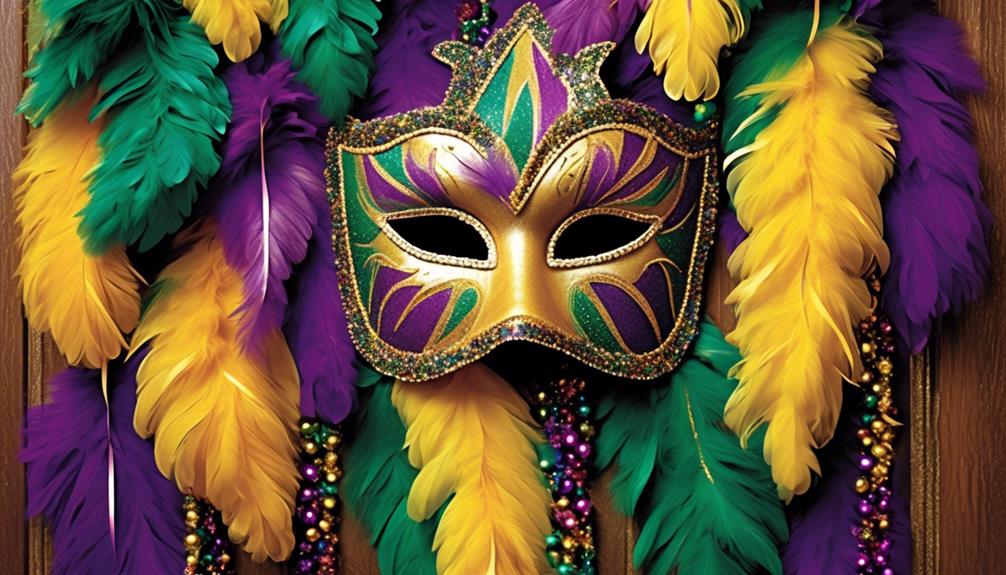
When it comes to decorating for Mardi Gras, we often struggle to find a balance between making a memorable impact and sticking to a budget. The key is to blend boldness and elegance, creating a festive atmosphere that embodies the essence of the holiday without being too overwhelming.
With a few simple yet creative ideas, you can transform any space into a festive Mardi Gras wonderland that will have everyone feeling the festive spirit.
Key Takeaways
- Mardi Gras decorations can include masks, jester hats, bead garlands, feather boas, and glittery table centerpieces.
- Masks can be painted with bold patterns and designs using acrylic paints and glitter.
- Jester hats can be created using colorful cardstock, glitter, bells, and elastic bands.
- Bead garlands can be used to decorate parade floats or create a festive atmosphere, and can also be used to create bead bracelets, necklaces, belts, and headpieces.
Colorful Mardi Gras Masks
Let's get ready to create vibrant and eye-catching Mardi Gras masks that will add a burst of color and excitement to our decorations. Mask painting is a delightful activity that allows us to express our creativity and add a personal touch to the festive ambiance.
To start, gather a variety of plain masks, acrylic paints, paintbrushes, glitter, feathers, and other embellishments. Begin by brainstorming designs and color schemes. Once you have a plan in mind, use the paint to create bold patterns, intricate designs, or even abstract art on the masks. Experiment with different brush strokes and techniques to achieve the desired effect.
Don't forget to let each layer of paint dry before adding new elements to avoid smudging or blending colors unintentionally. As the base design takes shape, explore mask decorating techniques such as adding glitter for a touch of sparkle or attaching feathers to create a dramatic effect.
These masks won't only enhance our decorations but also bring joy to those who see them. Let's share this creative experience with others and spread the vibrant spirit of Mardi Gras!
Festive Bead Garlands
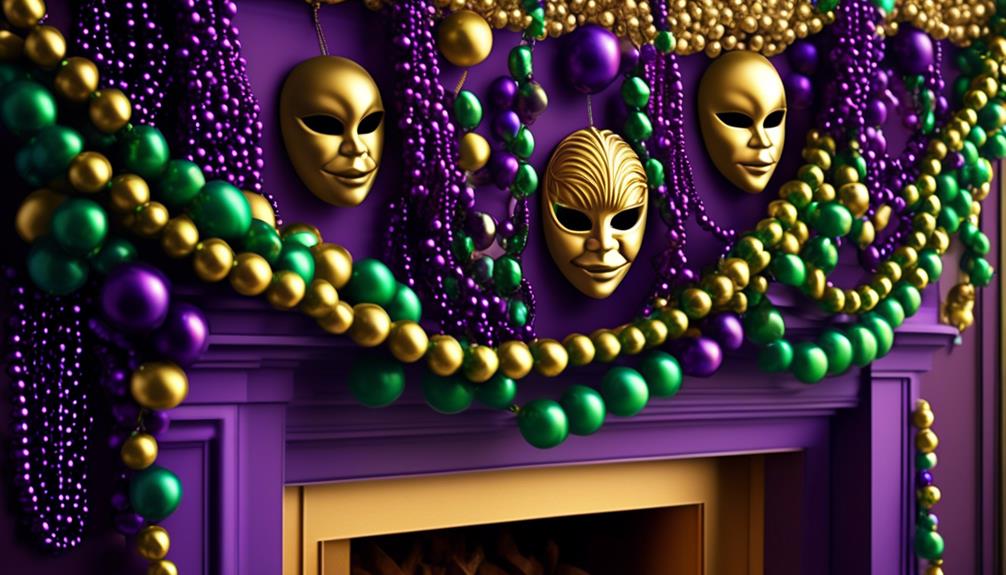
After creating our colorful Mardi Gras masks, we are now ready to dive into the world of festive bead garlands, adding a touch of elegance and flair to our decorations. Bead crafting techniques can elevate the ambiance of any Mardi Gras celebration. To assist you in this endeavor, we've compiled a selection of DIY costume accessories and parade float decorations that will surely delight your guests and spectators.
| Bead Crafting Techniques | Party Favor Ideas | DIY Costume Accessories | Parade Float Decorations |
|---|---|---|---|
| Stringing beads to create stunning garlands | Giving away homemade bead bracelets as party favors | Crafting bead necklaces, belts, and headpieces | Using bead garlands to adorn parade floats and create a festive atmosphere |
Vibrant Feather Boas
Let's talk about the vibrant feather boas!
When it comes to Mardi Gras decorations, feather boas are a must-have.
We'll explore the wide array of feather boa colors, embellishments, and creative hanging ideas to make your Mardi Gras celebration truly unforgettable.
Feather Boa Colors
What are the most vibrant colors available for feather boas to create eye-catching Mardi Gras decorations? When it comes to boa color trends, it's all about bold and lively hues that capture the festive spirit of Mardi Gras.
Here are some vibrant feather boa colors that will make your decorations stand out:
- Emerald Green: This rich and lush shade of green represents the traditional color of Mardi Gras and will instantly bring a touch of elegance to your decor.
- Royal Purple: A deep and regal purple adds a sense of grandeur to your Mardi Gras decorations, symbolizing justice and power.
- Golden Yellow: Bright and radiant, a golden yellow feather boa brings a vibrant burst of energy and joy to your festive arrangements.
These vibrant feather boa colors will elevate your Mardi Gras decorations and create a captivating visual experience for all.
Boa Embellishments
As we explore boa embellishments, we'll incorporate vibrant feather boas, such as emerald green, royal purple, and golden yellow, to infuse our Mardi Gras decorations with elegance and energy.
When creating a boa costume, these feather boas can be draped around hats, sewn onto dresses, or used as sashes for a fun and festive look.
For parade floats, consider using feather boas to adorn the edges, creating a lavish and eye-catching display. To make the most of these boas, intertwine different colors, layer them for a fuller effect, and mix and match textures for added visual appeal.
Additionally, feather boas can be used to create stunning table centerpieces or to embellish masks, adding a touch of glamour to your Mardi Gras celebration.
Boa Hanging Ideas
To create striking boa hanging decorations, select vibrant feather boas in rich colors such as emerald green, royal purple, and golden yellow to infuse your space with the lively spirit of Mardi Gras.
For an eye-catching boa display, consider these hanging arrangements:
- Boa Curtain: Drape long strands of feather boas across doorways or windows to create a dazzling curtain effect, welcoming guests with a festive flair.
- Boa Chandelier: Craft a stunning boa chandelier by suspending multiple boas from a wire frame or hoop, adding a touch of elegance and whimsy to your Mardi Gras festivities.
- Boa Garland: String together colorful feather boas to make a vibrant garland that can be hung along staircases, mantels, or tables, bringing a festive and playful atmosphere to any space.
These hanging arrangements will elevate your Mardi Gras decor and make your celebration truly unforgettable.
Glittery Table Centerpieces
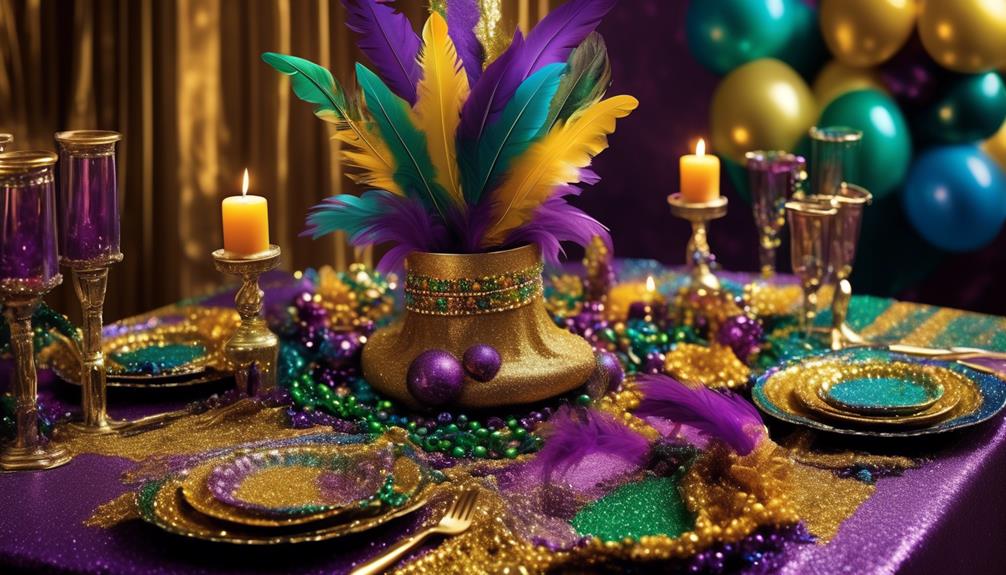
Let's talk about creating stunning glittery table centerpieces for your Mardi Gras celebration.
First, we'll cover the materials needed to bring these dazzling decorations to life.
Then, we'll provide step-by-step assembly instructions to ensure your centerpieces shine bright.
Materials Needed
We can create stunning glittery table centerpieces by gathering clear glass vases, glitter in various colors, mod podge, and paintbrushes for this craft project.
To make these beautiful centerpieces, we can use creative alternatives like recycled glass jars or repurposed wine bottles to serve as the vases. This not only adds a unique touch to the decorations but also provides budget-friendly options.
The glitter in various colors allows for personalization, and the mod podge acts as an adhesive and sealer, ensuring the glitter stays in place.
Paintbrushes are essential for applying the mod podge evenly and precisely onto the vases.
With these materials, we can bring a touch of sparkle and elegance to our Mardi Gras celebration.
Assembly Instructions
Using an assortment of clear glass vases, glitter in various colors, mod podge, and paintbrushes, we can proceed to assemble the glittery table centerpieces for our Mardi Gras celebration.
First, ensure the vases are clean and dry.
Next, apply a coat of mod podge to the outside of the vase using a paintbrush.
Then, sprinkle the glitter onto the mod podge, ensuring it covers the entire surface evenly. For a creative touch, consider mixing different colors of glitter or creating patterns.
Once the glitter is applied, let the vases dry completely.
To prevent the glitter from shedding, seal the glitter with another layer of mod podge.
Allow the vases to dry thoroughly before placing them on the tables.
These centerpieces will surely add a dazzling and festive touch to our Mardi Gras celebration.
Display and Enjoy
With our glittery table centerpieces assembled and dried, we can now showcase them as the sparkling focal point of our Mardi Gras celebration. Here's how to display and enjoy them:
- Place the glittery table centerpieces on the main dining table, ensuring they're evenly spaced to create a stunning visual impact.
- Surround the centerpieces with complementary party supplies such as colorful beads, masks, and feather boas to enhance the festive atmosphere.
- Encourage guests to snap photos with the beautiful DIY crafts and use them as conversation starters, adding an extra touch of charm to the celebration.
Homemade Jester Hats
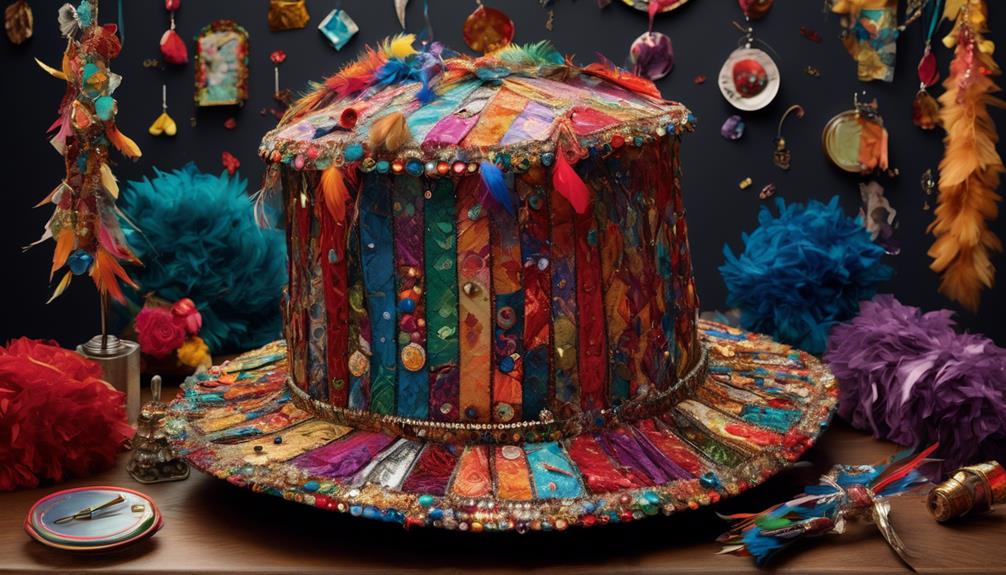
Crafting jester hats at home allows for personalized touches and creativity to shine through, adding a unique and festive flair to your Mardi Gras decorations.
Making DIY costume jester hats can be a fun and rewarding activity for both adults and kids. To start, gather supplies like colorful cardstock, glitter, bells, and elastic bands.
Cut the cardstock into long strips and staple or glue the ends together to form a band that fits around your head. Then, cut out diamond shapes from more cardstock and attach them to the band, alternating colors to create a vibrant, jester-style pattern.
Add glitter and bells for extra pizzazz. For the finishing touch, attach elastic bands to keep the hat in place.
These homemade jester hats can be great additions to your Mardi Gras party favors, and they also provide a delightful activity for guests to engage in during the celebration.
Sparkling Door Wreaths
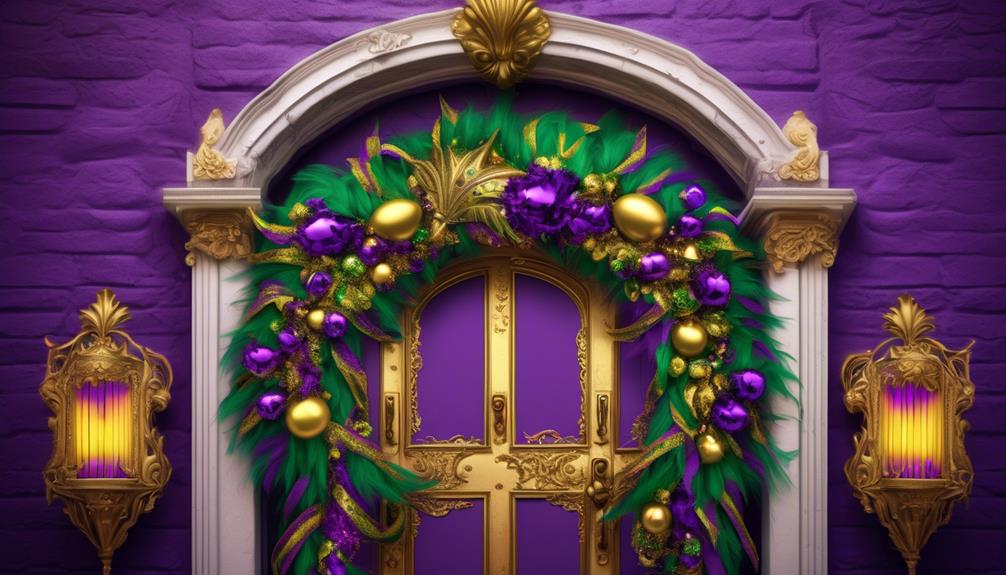
Let's create eye-catching sparkling door wreaths to add a touch of glamour and festivity to your Mardi Gras decor. Making a DIY wreath for Mardi Gras can be a fun and rewarding project. Here are some wreath decorating ideas to help you get started:
- Beaded Elegance: String colorful Mardi Gras beads around a foam or vine wreath base, securing them with hot glue. Add in some shimmering metallic beads for an extra touch of elegance.
- Feathery Flourish: Attach vibrant feathers in green, gold, and purple to the wreath using floral wire or hot glue. Layer the feathers for a lush and extravagant look.
- Glittering Accents: Sprinkle a foam or vine wreath with glitter in Mardi Gras colors. Secure the glitter with a clear sealant spray to prevent it from shedding. Then, add in some glittery Mardi Gras masks, fleur-de-lis ornaments, or decorative picks for a dazzling finish.
Creating your own sparkling door wreaths is a delightful way to showcase your creativity and bring the festive spirit of Mardi Gras to your home.
Masked Balloon Bouquets

After adorning our doors with sparkling wreaths, we can enhance our Mardi Gras decor by creating vibrant and festive masked balloon bouquets. These balloon sculptures add a touch of whimsy and elegance to any masquerade party.
To craft these stunning bouquets, start by selecting an assortment of Mardi Gras colored balloons, such as purple, green, and gold. Use a variety of sizes to add visual interest. Next, inflate the balloons and tie them off, ensuring they're fully inflated for a beautiful effect.
Once you have your balloons ready, attach them to balloon sticks or lightweight wooden dowels. To create the masked effect, attach elegant masquerade masks to the top of each bouquet. Secure the masks by tying them to the sticks with colorful ribbons that complement the balloon colors. Consider adding glitter or sequins to the masks for an extra festive touch.
Arrange the finished balloon bouquets in strategic locations around your party space, such as near the entrance, the dance floor, or the food table. These vibrant and eye-catching decorations will surely delight your guests and elevate the festive atmosphere of your Mardi Gras celebration.
Jazz-Inspired Wall Decor

Exploring the rhythmic and colorful essence of jazz, we can infuse our Mardi Gras decor with captivating and vibrant wall art inspired by the soulful melodies and spirited energy of this musical genre. Jazz music, with its improvisational nature and rich history, provides a perfect backdrop for artistic inspiration as we create stunning wall decor for our Mardi Gras celebrations.
- Musical Notes Mural: Adorn your walls with a larger-than-life mural depicting swirling musical notes in vibrant Mardi Gras colors. Let the notes dance across the wall, capturing the vivacious spirit of jazz music and adding a dynamic focal point to your decor.
- Vintage Album Cover Display: Showcase vintage jazz album covers in stylish frames, creating a gallery wall that pays homage to the classic artistry of the genre. The striking visuals and evocative designs of these album covers will infuse your space with the timeless allure of jazz.
- DIY Jazz-Inspired Art: Get creative and make your own jazz-inspired art pieces using mixed media, incorporating elements like musical instruments, bold colors, and expressive brushstrokes. These unique creations will bring an authentic and personalized touch to your Mardi Gras wall decor, reflecting the improvisational and eclectic nature of jazz.
Frequently Asked Questions
Where Can I Find Affordable Mardi Gras Decorations?
We usually find affordable Mardi Gras decorations at online retailers and local stores. Online retailers offer a wide variety of Mardi Gras decorations at competitive prices, while local stores may have unique and affordable options.
For budget-friendly options, we often opt for DIY decorations. When seeking budget-friendly options, DIY decorations can be a fun and cost-effective way to add a personal touch to your Mardi Gras decor.
Are There Any Traditional Mardi Gras Symbols That I Should Include in My Decorations?
Traditional symbols like fleur-de-lis, masks, and beads are essential for DIY Mardi Gras decorations. Incorporating these symbols can add an authentic touch to your decor. Look for affordable options at craft stores or online to stay within budget.
Get creative with colors and patterns to make your decorations stand out. These symbols will bring the festive Mardi Gras spirit into your home without breaking the bank.
How Can I Incorporate Mardi Gras Decorations Into My Outdoor Space?
We can incorporate Mardi Gras decorations into our outdoor space by creating DIY Mardi Gras themed crafts. Hanging colorful banners, making festive wreaths, and crafting unique yard signs are great ways to bring the Mardi Gras spirit outside.
We can also use traditional Mardi Gras symbols like fleur-de-lis and masks to add authenticity to our outdoor decor.
What Are Some Creative Ways to Display Mardi Gras Decorations in My Home?
We've found that a creative centerpiece is a great way to showcase Mardi Gras decorations in your home.
You can make a DIY garland using colorful beads, feathers, and masks to really bring the festive spirit to any room.
Can I Make My Own Mardi Gras Decorations Using Items I Already Have at Home?
Absolutely, we can create our own Mardi Gras decorations using household items. DIY decorations aren't only budget-friendly, but they also add a personal touch to our celebrations.
By repurposing items like colorful fabric, beads, and paper, we can craft vibrant and festive décor. From handmade masks to garlands, the possibilities are endless.
Let's get creative and infuse our homes with homemade Mardi Gras spirit!
Conclusion
So, let's get ready to jazz up our Mardi Gras celebrations with these fabulous decorations!
With colorful masks, festive garlands, vibrant feather boas, glittery centerpieces, homemade jester hats, sparkling wreaths, masked balloon bouquets, and jazz-inspired wall decor, our party is sure to be a sight to behold.
Let's bring the spirit of Mardi Gras to life with these dazzling and lively decorations that will transform any space into a festive and vibrant celebration!
- About the Author
- Latest Posts
Introducing Ron, the home decor aficionado at ByRetreat, whose passion for creating beautiful and inviting spaces is at the heart of his work. With his deep knowledge of home decor and his innate sense of style, Ron brings a wealth of expertise and a keen eye for detail to the ByRetreat team.
Ron’s love for home decor goes beyond aesthetics; he understands that our surroundings play a significant role in our overall well-being and productivity. With this in mind, Ron is dedicated to transforming remote workspaces into havens of comfort, functionality, and beauty.
-

 Retreat3 weeks ago
Retreat3 weeks agoIncorporating Biophilic Design in Your Retreat Center
-

 Retreat4 weeks ago
Retreat4 weeks agoDesigning a Retreat Center Kitchen: From Layout to Equipment
-

 Retreat4 weeks ago
Retreat4 weeks agoDIY Rustic Decor Ideas for a Cozy Retreat Atmosphere
-

 Southeast Asia Decor3 weeks ago
Southeast Asia Decor3 weeks agoUltimate Guide to Harmonious Furniture Placement
-

 Retreat2 weeks ago
Retreat2 weeks agoHow to Design and Build a Sweat Lodge for Your Retreat Center
-

 Retreat4 weeks ago
Retreat4 weeks agoThe Impact of Lighting on the Retreat Experience
-

 Southeast Asia Decor3 weeks ago
Southeast Asia Decor3 weeks agoHarmonizing Spaces: The Art of Feng Shui Design
-

 Southeast Asia Decor4 weeks ago
Southeast Asia Decor4 weeks agoFeng Shui Color Schemes Vs Traditional Indonesian Design




























